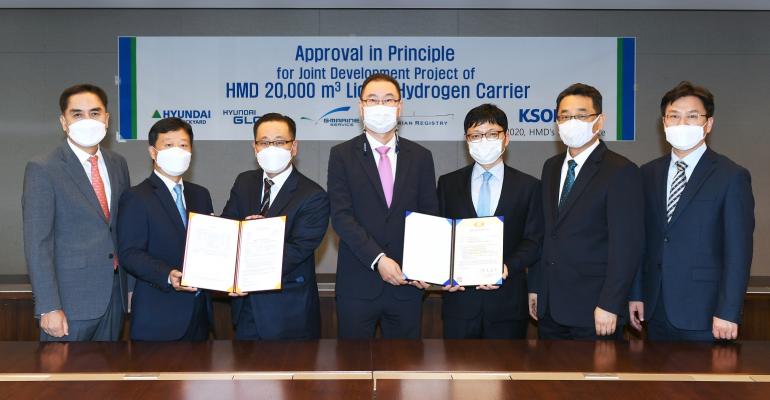On 22 October, HHI Group’s Korea Shipbuilding & Offshore Engineering (KSOE) and Hyundai Mipo Dockyard (HMD) announced that they have received the necessary Approval in Principle (AIP) for a 20,000 cu m class liquefied hydrogen carrier from the Liberian Registry as flag State and Korean Register as Class Society. This ship design is the world’s first large size liquefied hydrogen carrier.
“It is meaningful to participate in this joint industry project (JIP) of hydrogen carriers from the standpoint of a flag State with a long history and technical verification capability. As a flag State, our technical department has taken a very close look at the safety and regulatory aspects of the design and its implementation,” said Alfonso Castillero, Chief Operating Officer of the Liberian International Ship and Corporate Registry (LISCR).
The key elements of this JIP are the KSOE developed liquefied hydrogen cargo treatment system and a hydrogen boil off gas (BOG) treatment system using fuel cells. HMD advanced the basic design of the ship. Hyundai Glovis and G-Marine Service analysed the economics and safety of liquefied hydrogen during storage and transportation.
“We will actively pioneer overseas large-capacity hydrogen transportation market based on advanced technology," commented Hyundai Heavy Industries Group.
According to the ‘Hydrogen, Scailing Up’ Report released in 2017 by the Hydrogen Council, the global hydrogen market is expected to grow to $2.5trn by 2050, accounting for 18% of the total energy demand.
The Korean government announced the 'Road Map for Activating the Hydrogen Economy' last year, and is spurring the revitalisation of the hydrogen economy in various industries such as shipbuilding, automobiles and batteries.
This ship design is characterised by the use of a double-structured vacuum insulated tank to improve insulation and minimise hydrogen BOG generated during operation. In addition, by adopting an electric propulsion system, hydrogen BOG can be used as fuel for fuel cells in the future.
In order to transport a large amount of hydrogen by ship, a liquefaction process that reduces the volume to 1/800 and increases stability is essential. Since hydrogen liquefies at a cryogenic temperature of -253°C, which is lower than LNG that liquefies at -163°C, a liquefied hydrogen carrier needs advanced cryogenic technology to stably preserve it.

